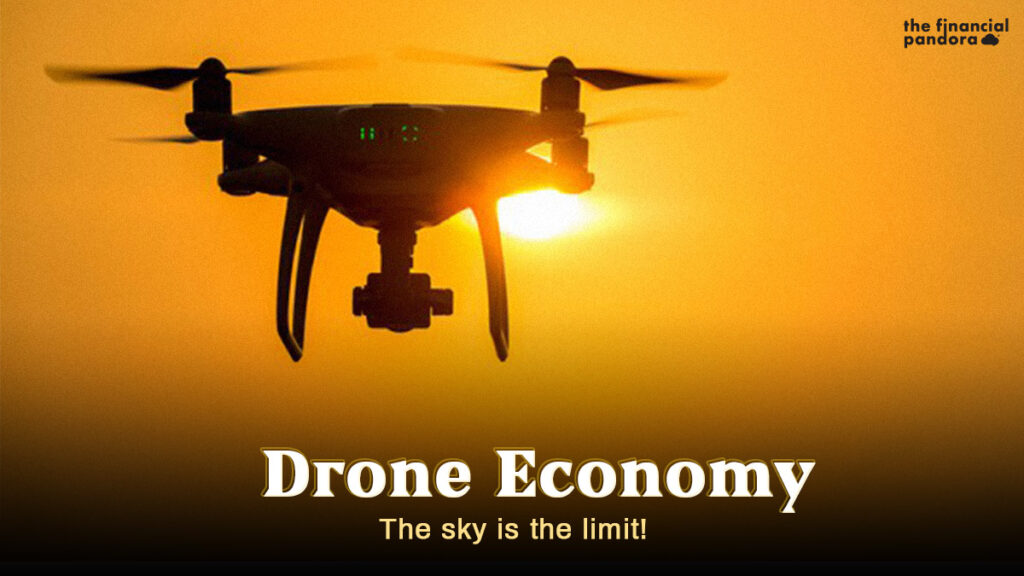From flying it for fun to inspecting the surface of Mars, drones have evolved far from small toys for the hobbyist to fully-featured complex autonomous robotics platforms with both real-world and out-of-this-world applications. As the potential for the commercial drone market size is expected to grow to USD 66.3 billion by 2025, the technology to support the intended applications has also been rising at an astonishing scale.
Translation? Economies of scale! The price and therefore the barrier to entry has decreased significantly over the years to spur more innovation.
Applications in the existing industries:
1. Agritech: Drones equipped with specialized sensors to monitor large farms, measure crop & soil health, spray fertilizers, irrigation inspection, and a lot more.
As drone technology continues to become more affordable and more accessible to all farmers around the world, their ability to grow more, healthier crops could prove to be a gamechanger for the global economy. The global agriculture drone market was USD 1.2 billion in 2020and is predicted to reach USD 5.7 billion by 2025.
2. Construction & infrastructure:
Drones with sophisticated sensors like topological mapping are helping construction crews and building inspectors around the world to build roads, bridges, homes, and skyscrapers bigger, faster, and safer. The construction drone market was USD 4.8 billion projected to reach USD 11.96 billion by 2027.
They are also used in the inspection and maintenance of oil rigs, pipelines for transportation of oil, and electricity infrastructures like transmission lines and junctions to better assess the problems and find solutions faster.
3. Disaster relief:
In an event of a disaster such as a forest wildfire, floods, etc. that render the ability of relief workers to physically visiting the affected areas difficult, drones are used to assess the situation on the ground and identify which part of areas need the most urgent help.
4. Photography & videography:
Drones with the capability of capturing high-resolution photos and videos have replaced the traditional use of helicopters with an attached camera for getting high-quality footage.
These tools have given a new perspective to photographers and videographers to present their work.
5. Military:
The biggest user of drone technology by far is the military. It accounts for around 70% of drones currently used with a global market size of USD 10.53 billion in 2019 which is projected to reach USD 23.78 billion by 2027, according to Fortune business insights
Be it just for surveillance purposes or attaching weapons of mass destruction to it, drones have proven very useful for the military of many countries around the world while also being one of the most debated uses of the technology.
Promising future applications:
1. Package delivery:
Companies like Amazon, Fed Ex, and DHL are investing heavily in drone technology to make last-mile delivery faster, cheaper, and more environmentally efficient.
Amazon, UPS, and Alphabet-owned Wing have received the approval from FAA to operate drones at a higher altitude to deliver packages to customers. This effort has been accelerated because of the COVID-19 pandemic to enable deliveries of packages with weight up to 5 lbs (2.27 kgs) within 30 minutes to minimize contact and reduce the risk of infection.
2. Cargo carrier:
The concept is to create an option that fits between inexpensive but time-consuming ocean freight and faster but very expensive cargo by air. Natilus, a US start-up is working on creating a solution to address this market.
3. Passenger taxi:
A fully automated drone that is big enough to carry passengers from point ‘a’ to point ‘b’ is in development. Uber and Hyundai have unveiled the plans for its flying taxi in CES 2020.
According to a Morgan Stanley report, the Autonomous urban aircraft market size is estimated to grow to USD 1.5 trillion by the year 2040.
Impact of 5G:
The advent of 5G tech enabling low latency high bandwidth connectivity will be a tremendous push for all Internet of Things (IoT) products. Drones can take the advantage of a strong 5G network to deliver a high-quality stream back to the user enabling faster and better decision making especially in the fields of disaster relief, infrastructure, and construction industries. 5G can also make it possible for drones to talk to other drones and aircraft and make a decision on their own to avoid collision or damage.
Creating an industry around drones:
As the use of drones has become more commercialized, the services like drone tracking (similar to the current flight tracking apps and website), drone intelligence, companies servicing drones and developing sophisticated attachments for using one drone for multiple purposes, etc. will grow around it to make drone technology as an industry in itself providing thousands of jobs in the process.
The World Drone Prix in Dubai in 2016 was the first million-dollar drone race, with the winning team taking home a cool USD 250,000.
Conclusion:
The current regulatory frameworks all around the world for flying and operating drones are slowly progressing towards easing of rules but are still complex requiring various permits, IDs, etc. sometimes even for recreational purposes citing safety and privacy reasons.
How will the drones fly in different sizes, shapes, and forms, Who will fly them, where they fly and what will be they used for are all problems to be solved.
This post was written in collaboration with Asif Yahiya Sukri LLP. Asif Yahiya Sukri LLP provides unparalleled personalized financial services to a broad range of clients across different geographical locations. With a presence in the USA, India and the MENA region, they ensure that all of your financial decisions are made carefully and with your best interests in mind. They are innovators who understand what goes into building companies.
You can also reach out to them on info@aysasia.com
Follow Us @




